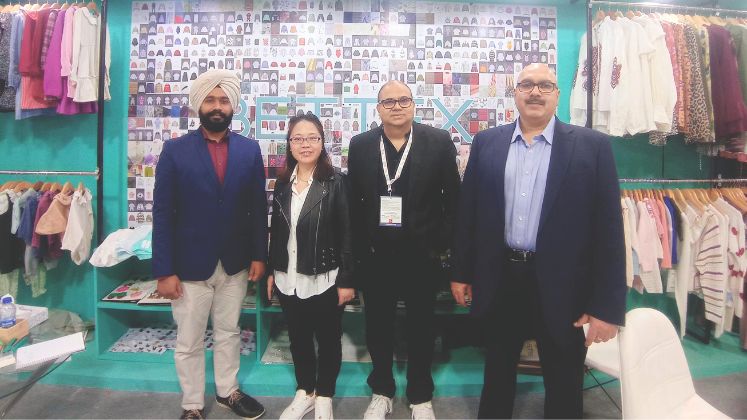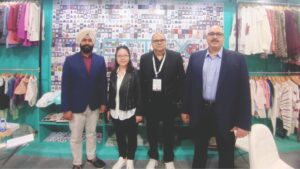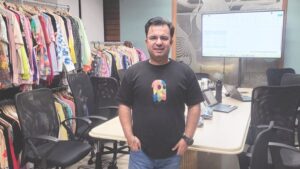
The fashion industry is at a turning point, with shifting trade policies, rising input and labour costs and supply chain disruptions forcing brands to rethink their sourcing strategies, explore new markets and diversify their product range.
As companies seek stability and cost efficiency, Bettex, a global leader in fashion solutions, is strengthening its presence in India and Bangladesh, leveraging affordable manufacturing, skilled workforce and strong export networks.
Founded in 2001 and headquartered at Weihai, Bettex is a key player in global fashion solutions, with a turnover of around US $ 750 million. The company specialises in woven outerwear, loungewear, knitwear, swimwear, activewear, accessories, homewear, yarn, fabric and trims, supplying to top international brands.
It also operates a design studio in London and has its marketing offices in Japan, Spain, Italy, Mexico and the USA, as well as sourcing offices in China, Dhaka, Gurugram, Tokyo and other locations. These offices focus on innovation in design while tracking emerging trends, colours, prints and consumer preferences.
The company has invested heavily in automation to boost efficiency and be more eco-friendly. It uses AI and 3D software to reduce physical sampling and improve product visualisation. Most of its products are made from recycled cotton and polyester.
In an exclusive chat with Apparel Resources, Susie Yi, Managing Director, Bettex UK; Anuj Malik, COO, Bettex UK and Avanish Walia, Director – Sourcing and Marketing, Bettex Bangladesh, mentioned that in early February, the US slapped a 10 per cent tariff on almost all Chinese imports, which has now jumped to 27.5 per cent. “This opens massive opportunities for India and Bangladesh to step in and fill the gap,” they said.
The trio also discussed their strategic plans for India and Bangladesh and their vision for growth in these key markets. Here are the excerpts:
AR: Can India and Bangladesh outshine China, Vietnam and Cambodia in sourcing?
Anuj Malik: Each country has its unique strengths in manufacturing. Traditionally, India and Bangladesh have had longer lead times, which deterred some customers. However, with changing tariffs and increasing operational costs in China, brands are now exploring alternative sourcing hubs. Vietnam continues to be appealing to premium customers. Cambodia offers its advantages but is facing labour challenges, with wages increasing from US $ 180 to nearly US $ 300 due to poaching. Nevertheless, its duty-free access makes it a strong competitor to Bangladesh, particularly for the European and Canadian markets. At Bettex, we’ve turned these challenges into opportunities by reducing lead times and expanding vertically in Bangladesh. Additionally, we plan to tap into the great potential of India by leveraging India’s strengths and diversifying into non-traditional Indian products.
Susie Yi: We already have our own spinning facilities and dyeing operations in China. To reduce dependency and accelerate production, we stock fabrics in Bangladesh and maintain large warehouses. This allows us to start production immediately without waiting for fabric shipments from China, cutting down transit delays.
Today, customers prioritise service and speed. If they need colour approvals, instead of waiting for samples to arrive from China, we can now provide approvals within a week from our stock in Bangladesh.
Traditionally, our lead time was around 120 days. By optimising our processes, we have brought this down to 90 days and are working towards a target of 75 days, making Bangladesh a more competitive sourcing hub.
China remains the fastest and most cost-effective sourcing hub. However, we are bringing that same efficiency to Bangladesh. Earlier, Bangladesh was known for large production runs, but we’ve made it possible to fulfil even small orders of 500 pieces from there.
If you need a red fabric but don’t meet the MOQ for custom dyeing, we maintain a selection of pre-dyed red shades in stock. This allows you to choose the closest match instead of waiting for a custom batch, ensuring faster turnaround times.
Avanish Walia: We started our Bangladesh operations in 2019. Currently, we have two sweater facilities and one outerwear facility in Bangladesh and maintain strategic partnerships with around 25 different suppliers and factories, producing around 9 million pieces annually. By 2025, we plan to have five factories in Bangladesh.
Just as we’ve expanded successfully in Bangladesh, we’re committed to doing the same in India.
For instance, we’re expanding our manufacturing base in the country, particularly for cotton-based products, where India has a strong advantage. With India’s economy growing at an impressive pace and its retail market booming, we’re also strengthening our supply chain across India and Bangladesh to better support this growth.
| High-quality Products
I don’t believe focusing only on basic items is the right path to growth. Producing basic items like T-shirts valued at US $ 1, even in large quantities, brings limited value. On the other hand, high-value products like jackets, which range from US $ 5 to US $ 15, require a strong production base. – Avanish Walia |
AR: In 2017, India exported the highest number of T-shirts at an FOB price of US $ 2.75. Over the next seven years, the price has dropped by 15 per cent to US $ 2.39, despite rising manufacturing costs. Instead of FOB prices increasing, only manufacturing costs are rising. Where do you think the problem lies?
Avanish Walia: I don’t believe focusing only on basic items is the right path to growth. Producing basic items like T-shirts valued at US $ 1, even in large quantities, brings limited value. On the other hand, high-value products like jackets, which range from US $ 5 to US $ 15, require a strong production base. Bangladesh has successfully captured this market by adopting Chinese technology and ensuring easy access to raw materials.
Anuj Malik: To stay competitive, India needs to closely assess its production processes, identify inefficiencies and work on improving them. Currently, this focus is lacking in commodity products, as labour is abundant, leading to less emphasis on optimising operations. Moreover, the government has not provided sufficient support to build the necessary infrastructure for high-value products. A significant challenge is that India is yet to establish a cost-competitive base. For example, if we lack certain raw materials for MMFs (Man-Made Fibres), we should allow duty-free imports to remain competitive. However, there has been limited government initiative in this regard. While polyester production has begun locally, it remains expensive. Despite China having higher wages, its lower raw material costs make its prices more competitive than ours. Quality is another hurdle. Although we can improve through training, we first need the right infrastructure to support better manufacturing standards. That said, I remain optimistic about India’s future. With its talent, resources and ambition, I believe India can play a key role in serving the global market more effectively. In light of global political changes, companies like ours are offering solutions through a multi-country production base. Bettex provides customers with the same products that China offers but sourced from countries like India and Bangladesh. With a strong vertical integration in fabrics and trims, we continue to position ourself as a key solution provider for our customers.






